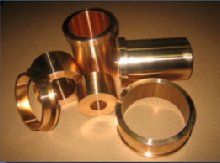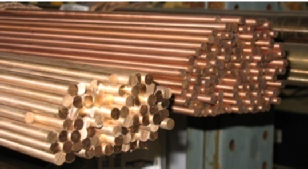





Sitemap
Careers




Download


Contact Us



© 2025 NGK BERYLCO. All rights reserved.
Heat treatment
Heat treatment is the most important process for this alloy system. While all copper alloys are hardenable by cold working, beryllium copper is unique in being hardenable by a simple low temperature thermal treatment. It involves two basic steps. The first is called solution annealing and the second, precipitation or age hardening.
Solution Annealing
The material is heated to within about 100°C of the alloy melting temperature. At this point the contained beryllium is essentially “dissolved” in the copper matrix (alpha phase). By rapidly quenching to room temperature this solid solution structure is retained. The material at this stage is very soft and ductile and can be readily cold worked by drawing, forming rolling, or cold heading.
The solution annealing operation is part of the process at the mill and is not typically used by the customer. Temperature, time at temperature, quench rate, grain size, and hardness are all very critical parameters and are tightly controlled by NGK Berylco.
Age Hardening
Age hardening significantly enhances the material’s strength. This reaction is generally carried out at temperatures between 260°C and 540°C depending on alloy and desired characteristics. This cycle causes the dissolved beryllium to precipitate as a beryllium rich (gamma) phase in the matrix and at the grain boundaries. It is the formation of this precipitate which causes the large increase in material strength. The level of mechanical properties attained is determined by the temperature and time at temperature. It should be recognized that beryllium copper has no room temperature aging characteristics. Material is available from NGK Berylco in the annealed cold worked or age hardened condition.












Products



ADVANTAGES
High strength
High fatigue life
Good conductivity
Good formability
Corrosion resistance
Stress relaxation
Wear & abrasion resistance
Wide temperatures range
Non-magnetic
Non-sparking
ADVANTAGES


| Introduction |
| History |
| Activities |
| Quality |
| Environment |
| R&D |
| Inventory |
| Satisfaction clients |
| Management |
| Certificates |
| Management |
| REACH & RoHS |
| Recycling |
| Strip |
| Wrought |
| Wire |
| Chill Vents |
| Safety Tools |
| Beryllium |
| Special products |
| Brochures |
| Products |
| Properties |
| Alloys |
| Heat-Treatment |
| Spring & Miniaturisation |
| Formability |
| Properties |
| Alloys |
| Products |
| Heat-Treatment |
| Plastic Industry |
| Introduction |
| Advantages |
| Design |
| Properties |
| Products |
| Alloys |
| Products |
| Information |
| Markets |
| Applications |
| NGK Berylco Worldwide |
| NGK Berylco Europe |
| Where to find us ? |
| Careers |
| Contact |
| Events |
| News |
| Links |